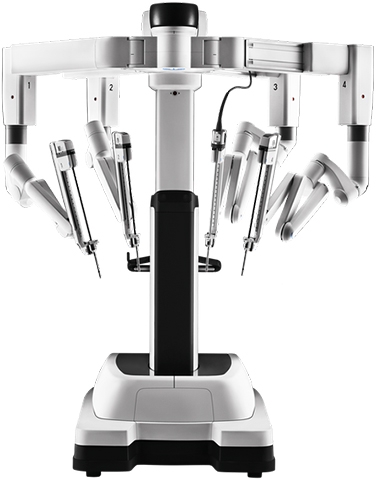A gastrectomy is a surgical removal of all or part of the stomach. When this procedure is performed by a doctor using an advanced surgical device called the da Vinci Surgical System, it is referred to as a robotic surgery or robotic gastrectomy.
Key Facts
- Robotic gastrectomy surgery may be recommended as a treatment for stomach cancer.
- Robotic instruments bend and rotate in many ways, often leading to better surgical outcomes, lower complication rates, and less scarring
- Despite the name, robotic surgery is not actually performed by a robot! The surgeon is in complete control of the device at all times.
Purpose
Robotic surgery enables surgeons to operate through a few small incisions (cuts) instead of the single large incision used in traditional open surgeries. In this way, it is similar to another form of minimally invasive surgery called laparoscopic surgery--however, unlike laparoscopic surgery, robotic surgery uses a higher definition camera and more advanced instruments that are attached to a four-armed robot.

The robot arms are operated by a surgeon using a robotic console, and the surgeon is in control the entire time.
The proper name for the robot and console is the da Vinci XI surgical system. The da Vinci System gives surgeons:
- A three dimensional high-definition view inside your body
- Wristed instruments that bend and rotate like the human hand but with greater range of motion
- State-of-the art energy and stapling devices to optimize dissection, cutting, and bowel connections
Robotic gastrectomy can be a good option to treat gastric adenocarcinoma, the most common form of stomach cancer, especially for obese patients and those with smaller tumors. Obese patients require particularly large incisions during traditional surgery, so the difference in incision sizes between open and robotic surgeries is the greatest for larger patients. Since the resected tumor and surrounding stomach must be removed through an incision, the advantages of robotic surgery are diminished for a very large tumor or for a total gastrectomy (complete removal of the stomach), as these may require enlarging one of the initial, smaller incisions.
Gastrointestinal stromal tumors and neuroendocrine tumors (a.k.a. carcinoid tumors) are less common forms of stomach cancer that can also be removed using robotic surgery.
There are several benefits to robotic surgery:
- Reduced pain
- Lower risk of infection or other complications
- Less blood loss (fewer transfusions)
- Shorter hospital stays
- Less scarring due to smaller incisions
- Faster return to normal function (work and daily activities)
- Often offer better short-term surgical outcomes
Procedure
In a robotic gastrectomy, the patient is first placed under general anesthesia. Once the patient is asleep, the surgeon will make four small incisions. The robotic surgical instruments and camera will be placed through these incisions, and the surgeon will work at a nearby console within the operating room to direct the robotic tools. The robotic operation typically takes an hour longer than a traditional, open surgery.
Alternatives
The main alternatives to robotic gastrectomy are traditional, open gastrectomy and laparoscopic gastrectomy.
Many medical research studies cite the safety and advantages to having robotic gastrectomy surgery, but the ultimate decision on which approach to choose will depend on the nature of the tumor being removed, the preference of the patient, and the skill level of the surgeon.
Risks and Complications
As with any surgery, there are risks and complications associated with a robotic gastrectomy, including bleeding, infection, and reaction to anesthesia.
Robotic surgery for stomach cancer has a learning curve of twenty or more cases, and thus this type of surgery is best performed by a high-volume stomach cancer surgeon.
Recovery
While the length of operation is generally longer for the robotic procedure versus laparoscopic or traditional surgery, robotic gastrectomy typically leads to quicker recovery time than other approaches. Other benefits include:
- Reduced pain
- Lower risk of infection or other complications
- Less blood loss (fewer transfusions)
- Shorter hospital stays
- Less scarring due to smaller incisions
- Faster return to normal function (work and daily activities)
- Often offer better short-term surgical outcomes
Next Steps
If you or a loved one may need a procedure like a robotic gastrectomy for stomach cancer, our Gastric Cancer Care Program can help. Stomach cancer is uncommon in the United States, which means that most surgeons do not have a significant amount of experience in stomach cancer surgery. At Columbia, our program features some of the highest-volume stomach cancer surgeons in the country. Studies from United States cancer databases have shown that high volume surgeons have better short term outcomes (e.g. fewer complications) and better long term outcomes (e.g. increased overall survival) than lower volume surgeons.
For more information about the Gastric Cancer Care Program or to request an appointment, please call (212) 305-0273.
